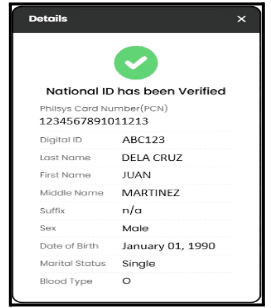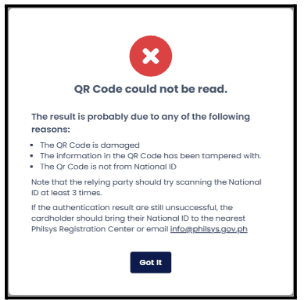PSA urges acceptance of Digital National IDs for identity verification
Digital National IDs, like their physical counterparts, should also be accepted by public, government, and private institutions as valid and sufficient proof of identity, the Philippine Statistics Authority (PSA) stressed.
The PSA reminded, however, that institutions may also verify the authenticity of the digital ID if in doubt.
But first things first, only those who registered for national ID can generate their digital ID through https://national-id.gov.ph/ or through the eGov PH application.
Registered citizens may also take a screenshot of their digital national ID to obtain a personal copy.
For relying parties to verify the digital national ID, they just need to access the website: https://everify.gov.ph/check which allows them to verify and authenticate the digital ID by scanning its QR code placed at the back portion.
This can be done by positioning the QR code within the camera's frame, ensuring all four corners are visible, and then the camera will automatically capture the QR code.
There are two possible responses when scanning the QR code of the digital national ID using the National ID check: “successful verification” and “QR code could not be read”.
Successful verification
If the verification is successful, the following result will appear as the image below shows:

It will show the user’s:
- National ID Card Number
- Digital ID Number
- Last Name
- First Name
- Middle Name
- Suffix
- Sex
- Date of Birth
- Marital Status
- Blood Type
If the digital national ID is authentic and has not been tampered with, a pop-up message "National ID has been Verified" will be displayed along with the demographic information of the registered citizen.
The information displayed in the verification result should match with the digital national ID.
If the data matches, it means that the digital ID is valid and should be accepted when transacting with any government or private institution.
Unsuccessful
On the other hand, if the authentication is unsuccessful, it will show the result depicted in the image below:

It will show the possible reasons why the QR code was not authenticated.
- The QR Code is damaged.
- The information in the QR Code has been tampered with.
- The QR Code is not from the National ID.
On top of it, a pop-up message “QR Code could not be read.” will be displayed for unsuccessful verification.
But fret not, it is recommended that the relying party scan the digital national ID at least three times.
If the authentication result is still unsuccessful at the third attempt of scanning, the relying party may advise the digital ID owner to report the incident to the nearest PSA office.
Recommended for low-risk transactions
The PSA stated that the website for the digital national ID is mostly for low-risk transactions and advised relying parties to onboard with the PSA through an application to the National ID Authentication Services.
“The National ID Check is a significant step towards the digitalization of processes in the country by promoting efficiency, security, and transparency in transactions across various sectors,” it noted.
For suspected fraudulent activities related to the national ID, the public is encouraged to report the incident to the PSA-PhilSys Registry Office through its official communication channels: (1) PhilSys hotline 1388; (2) email at [email protected]; and (3) Facebook page (facebook.com/PSAPhilSysOfficial).